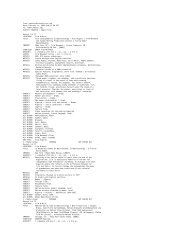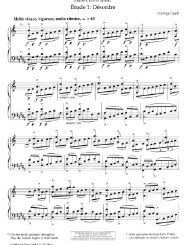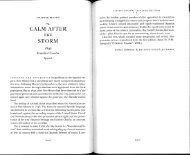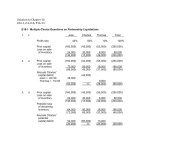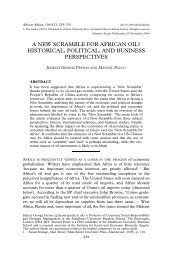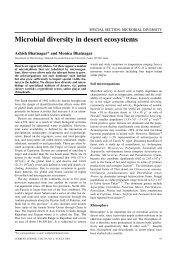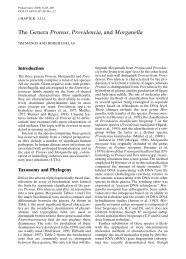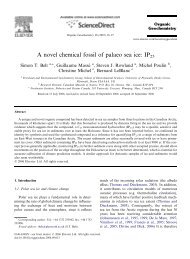Analysis by Key: Another Look at Modulation
Analysis by Key: Another Look at Modulation
Analysis by Key: Another Look at Modulation
Create successful ePaper yourself
Turn your PDF publications into a flip-book with our unique Google optimized e-Paper software.
F<br />
#, o f<br />
te n (t---V-8a' ^r 2 f 0 r i kj rJ4 7 C 0 CS<br />
Ex. 4a Bach: WTC I, Prelude 10<br />
ANALYSIS BY KEY<br />
Fovev '9$t'°-__#-'- Asserts A minc)r - " r C S C J J Jw 2 ji22 FEminor u - #2 2 pedal S j<br />
re-established<br />
Mdgd e: iV<br />
(mostly?<br />
Fdgd(= a : I )<br />
6 V I<br />
(a:I/e: IV)<br />
Ex. 4b<br />
Q (9 @ (R (i) (@<br />
2 l<br />
9 '51 /: -- '<br />
I<br />
iV<br />
(a: I<br />
6<br />
V<br />
/e:1V)<br />
It<br />
note bl. At the same time, however, bs 30-2, with their prominent<br />
passing<br />
dirninished fifth from A down<br />
note<br />
to<br />
A, so<br />
D",<br />
th<strong>at</strong> the<br />
effectively cancel<br />
prolonged<br />
the tonic<br />
harmony quality<br />
changes<br />
of<br />
its<br />
the<br />
guise, it stands revealed as the<br />
function; dropping<br />
subdominant<br />
its<br />
of E<br />
tonic<br />
it has been all along. The<br />
minor<br />
two<br />
th<strong>at</strong>, in<br />
graphs<br />
a<br />
of Ex.<br />
deeper<br />
4<br />
sense,<br />
As far as it goes, Tovey's<br />
<strong>at</strong>tempt to depict<br />
description is<br />
these<br />
correctevents.<br />
understand the correct,<br />
're-established' E<br />
th<strong>at</strong> is,<br />
minor<br />
as<br />
as an<br />
long as we<br />
not yet the boundary of a<br />
expected<br />
time<br />
focal<br />
span<br />
point or<br />
filled with<br />
centre,<br />
the<br />
but<br />
Indeed it is not even the<br />
E minor<br />
boundary of<br />
chord<br />
a<br />
as a<br />
key, for<br />
m<strong>at</strong>rix.<br />
specify just where in<br />
it is<br />
bs 30-2<br />
difficult<br />
the<br />
or<br />
key of E<br />
impossible to<br />
boundaries of keys are<br />
minor<br />
often<br />
begins to<br />
indistinct).<br />
reappear (the<br />
Tovey's interpret<strong>at</strong>ion is<br />
Perhaps the<br />
th<strong>at</strong> its<br />
gre<strong>at</strong>est<br />
exclusive<br />
weakness of<br />
seems to have blocked access<br />
concentr<strong>at</strong>ion<br />
to<br />
on<br />
the<br />
key<br />
underlying<br />
succession<br />
awareness of the vast IV-V-I<br />
difference in progression<br />
structural<br />
and to an<br />
b.32 and a true tonic, say<br />
meaning<br />
the final<br />
between the<br />
chord<br />
E<br />
of the<br />
chord of<br />
Changing the key of a<br />
piece.<br />
prolonged<br />
resource cre<strong>at</strong>ing,<br />
harmony is<br />
as<br />
a<br />
it<br />
most<br />
were, a 'pivot<br />
irnportant<br />
chord' of high<br />
compositional<br />
the Bach Prelude, an initially<br />
structural<br />
tonicized<br />
order.<br />
chord<br />
Often,<br />
will<br />
as in<br />
to the main tonic before<br />
begin<br />
th<strong>at</strong><br />
to suggest a<br />
resolution occurs<br />
resolution<br />
'future'). In many (again<br />
son<strong>at</strong>a-form projecting a<br />
movements<br />
sense<br />
in<br />
of<br />
development continues to<br />
major,<br />
prolong<br />
for<br />
the example,<br />
dominant<br />
the<br />
th<strong>at</strong> is tonicized in the second<br />
293<br />
MUSIC ANALYSIS 6:3, 1987



